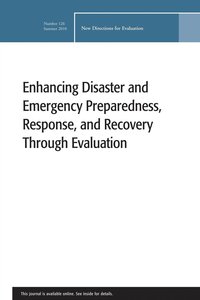
Enhancing Disaster and Emer Prep, Resp, and Recovery Through Evaluation EV Upplaga 1
The first priniciple of humanitarian assistance is "do no harm." The second might be, "do better!" Enter the evaluation of emergency and disaster management. This issue consolidates reflections from evaluation practices in disaster and emergency management. A number of important themes are addressed: * systemic assessment of needs * interagency coordiantion * evaluation of responses in real time * evaluation in international and national jurisdictions Chapters discuss where the evaluation of humanitarian practice and emergency and disaster management currently stands, and where it should be going. Our humanitarian impulse, as in the aftermaths of the Rwandan genocide, Hurricane Katrina, the Indian Ocean tsunami, and the January 2010 earthquake in Haiti, is an enduring quality. The route from donor to affected population is long and varied. When sudden, unprecedented needs are juxtaposed with expectional levels of charitable responses, the question is whether the responses were good enough. Did supply meet demand? Was it the right thing? Was it done well? Who received support? Was it appropriate? Was the timing right? Can it be improved? All are questions for evaluation. For populations traumatized by disaster, the answers have consequences for protection, for restoration of individual and community efficacy, and ultimately for hope and dignity. This is the 126th volume of the volume of the Jossey-Bass quarterly report series New Directions for Evaluation, an official publication of the American Evaluation Association.
Upplaga: 1a upplagan
Utgiven: 2011
ISBN: 9780470769126
Förlag: John Wiley & Sons
Format: Häftad
Språk: Engelska
Sidor: 128 st
The first priniciple of humanitarian assistance is "do no harm." The second might be, "do better!" Enter the evaluation of emergency and disaster management. This issue consolidates reflections from evaluation practices in disaster and emergency management. A number of important themes are addressed: * systemic assessment of needs * interagency coordiantion * evaluation of responses in real time * evaluation in international and national jurisdictions Chapters discuss where the evaluation of humanitarian practice and emergency and disaster management currently stands, and where it should be going. Our humanitarian impulse, as in the aftermaths of the Rwandan genocide, Hurricane Katrina, the Indian Ocean tsunami, and the January 2010 earthquake in Haiti, is an enduring quality. The route from donor to affected population is long and varied. When sudden, unprecedented needs are juxtaposed with expectional levels of charitable responses, the question is whether the responses were good enough. Did supply meet demand? Was it the right thing? Was it done well? Who received support? Was it appropriate? Was the timing right? Can it be improved? All are questions for evaluation. For populations traumatized by disaster, the answers have consequences for protection, for restoration of individual and community efficacy, and ultimately for hope and dignity. This is the 126th volume of the volume of the Jossey-Bass quarterly report series New Directions for Evaluation, an official publication of the American Evaluation Association.
Begagnad bok (0 st)
Varje vecka tillkommer tusentals nya säljare. Bevaka boken så får du meddelande när den finns tillgänglig igen.



